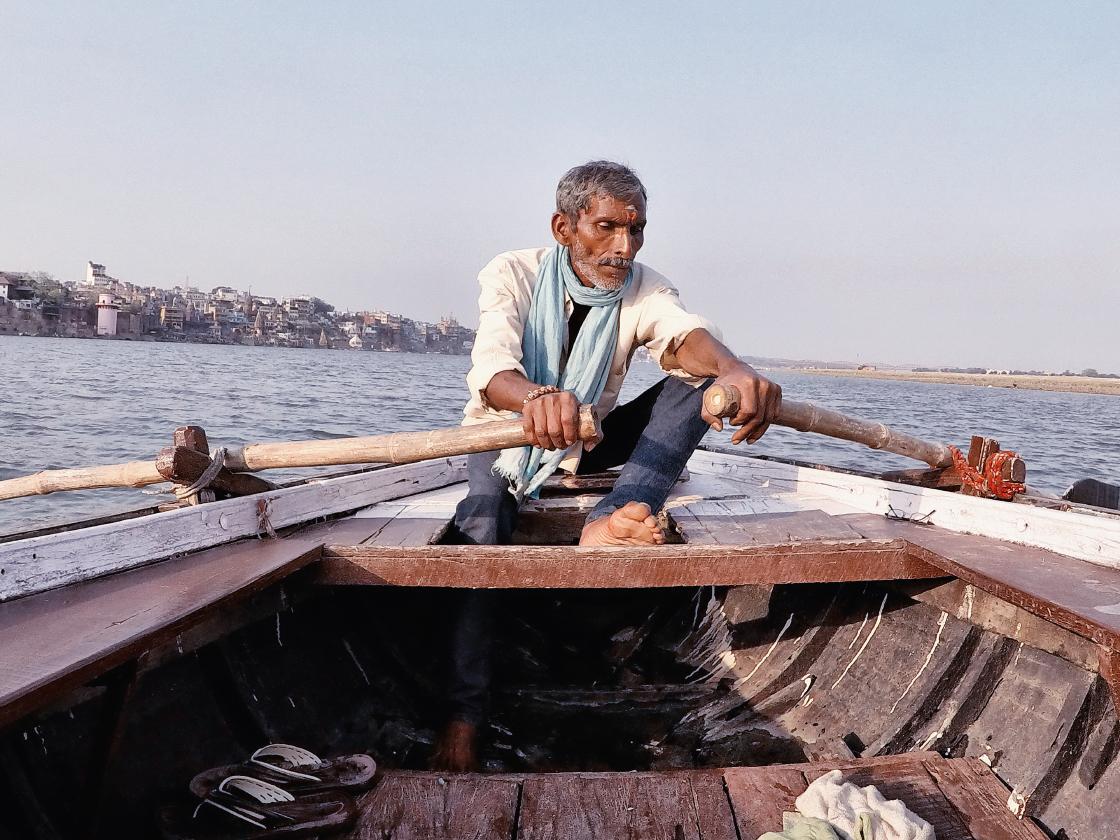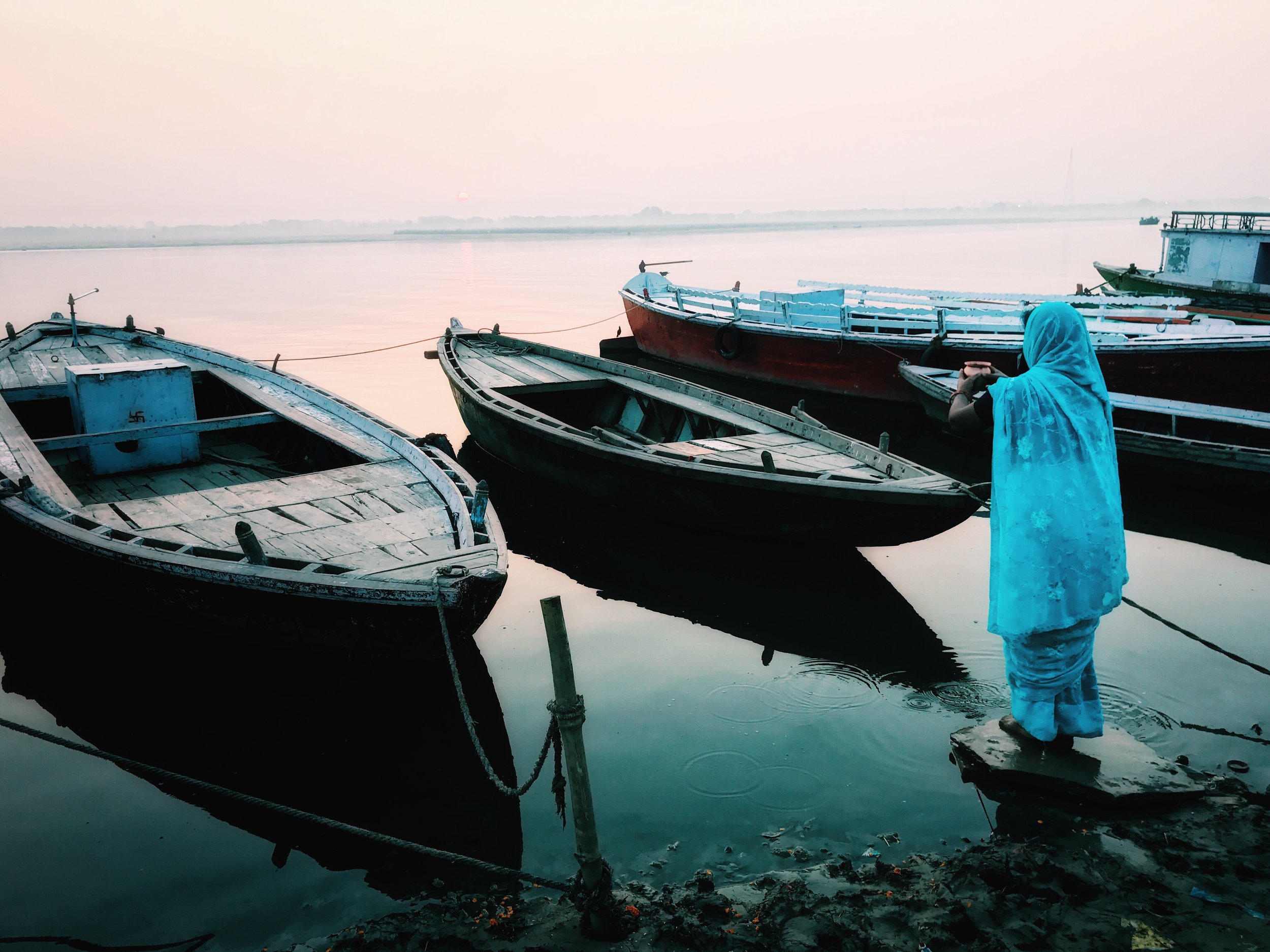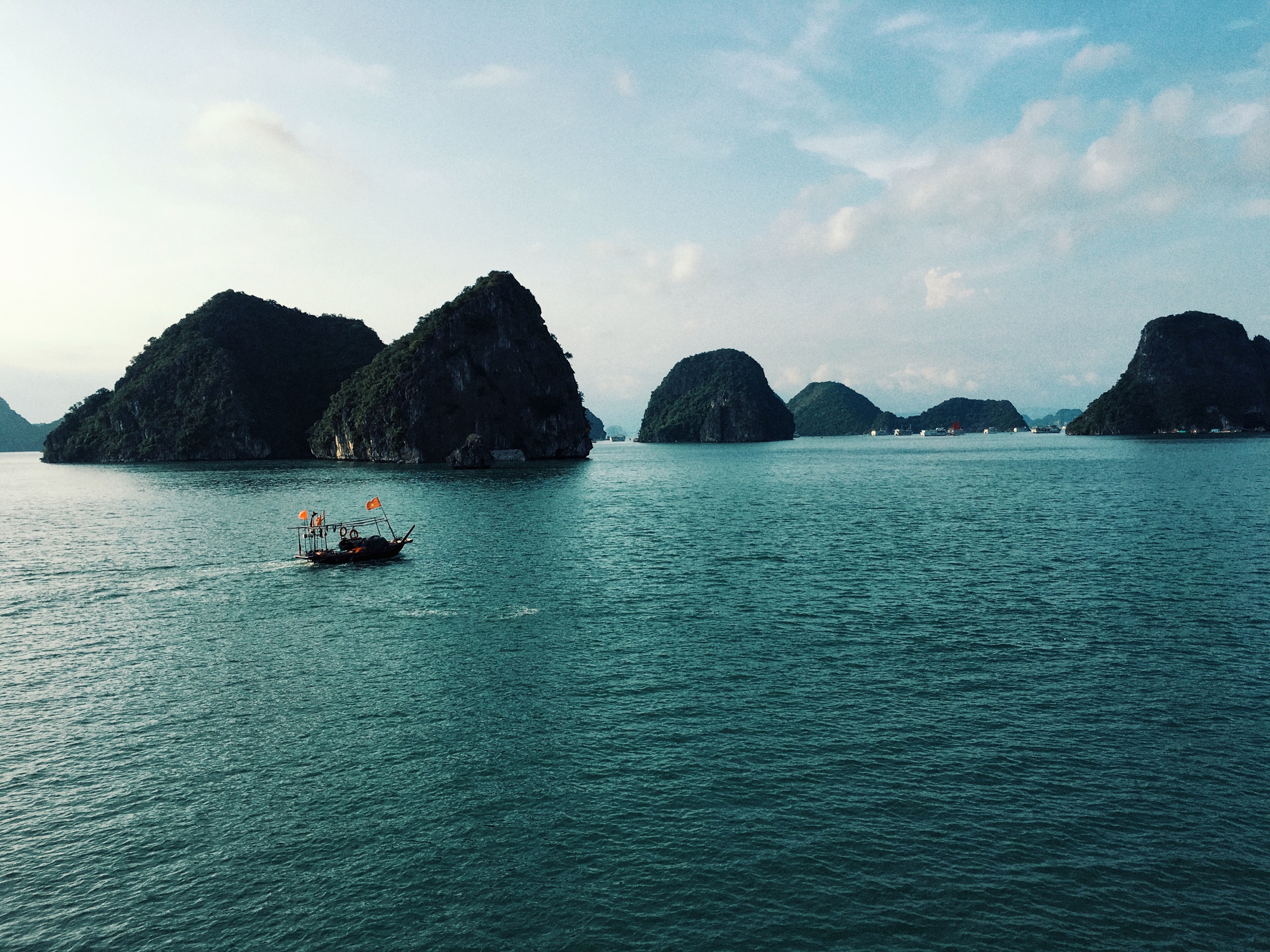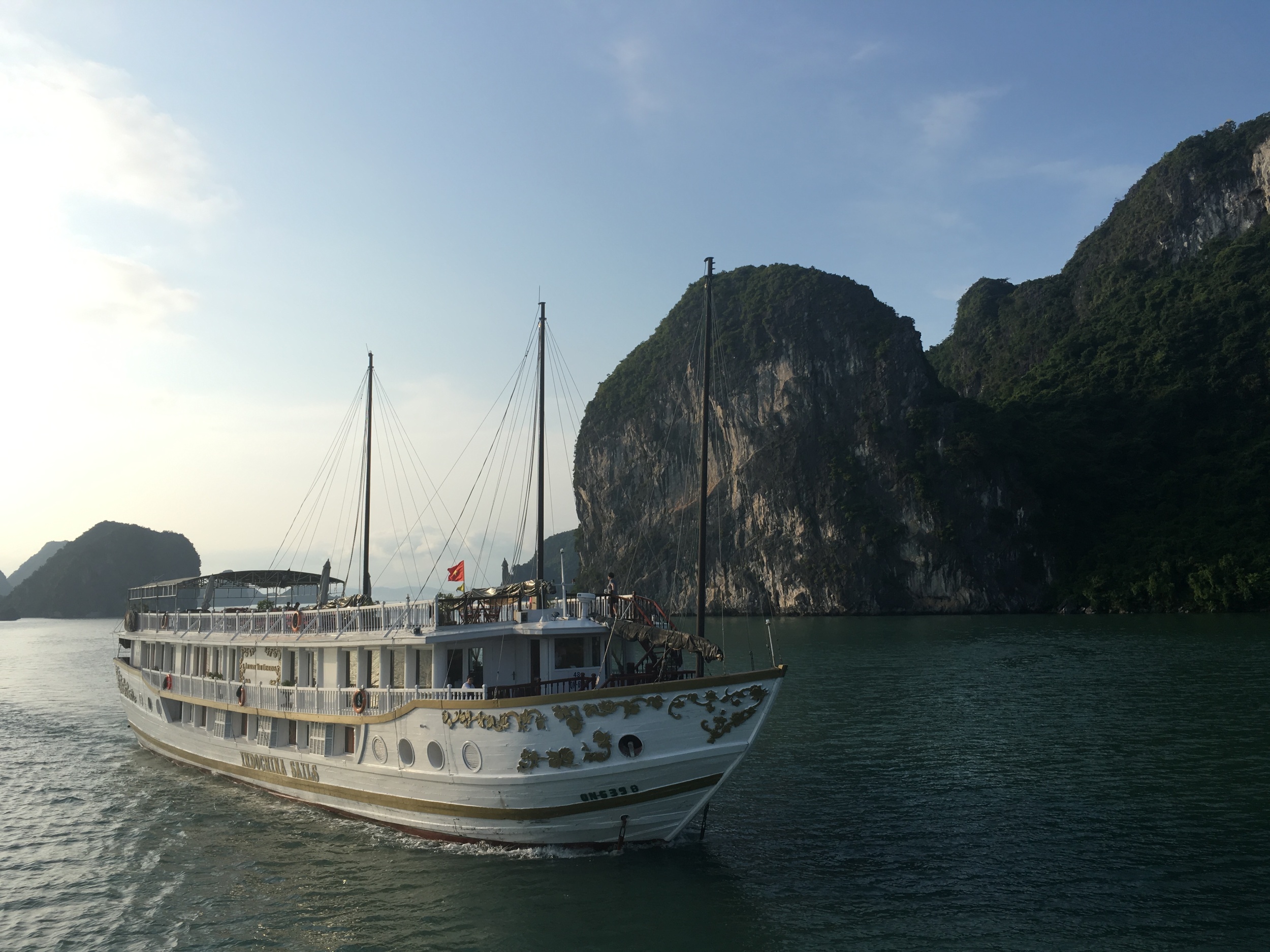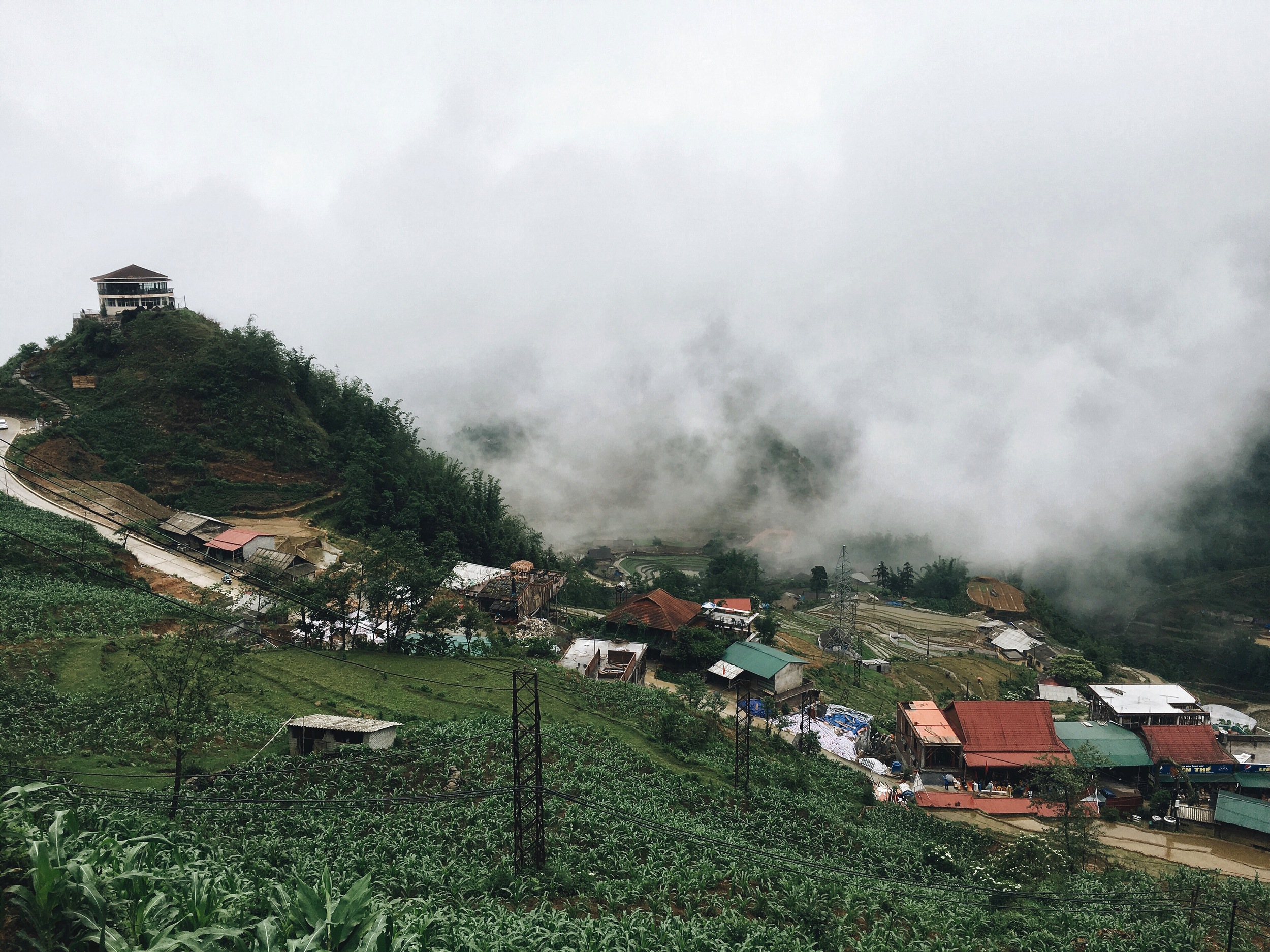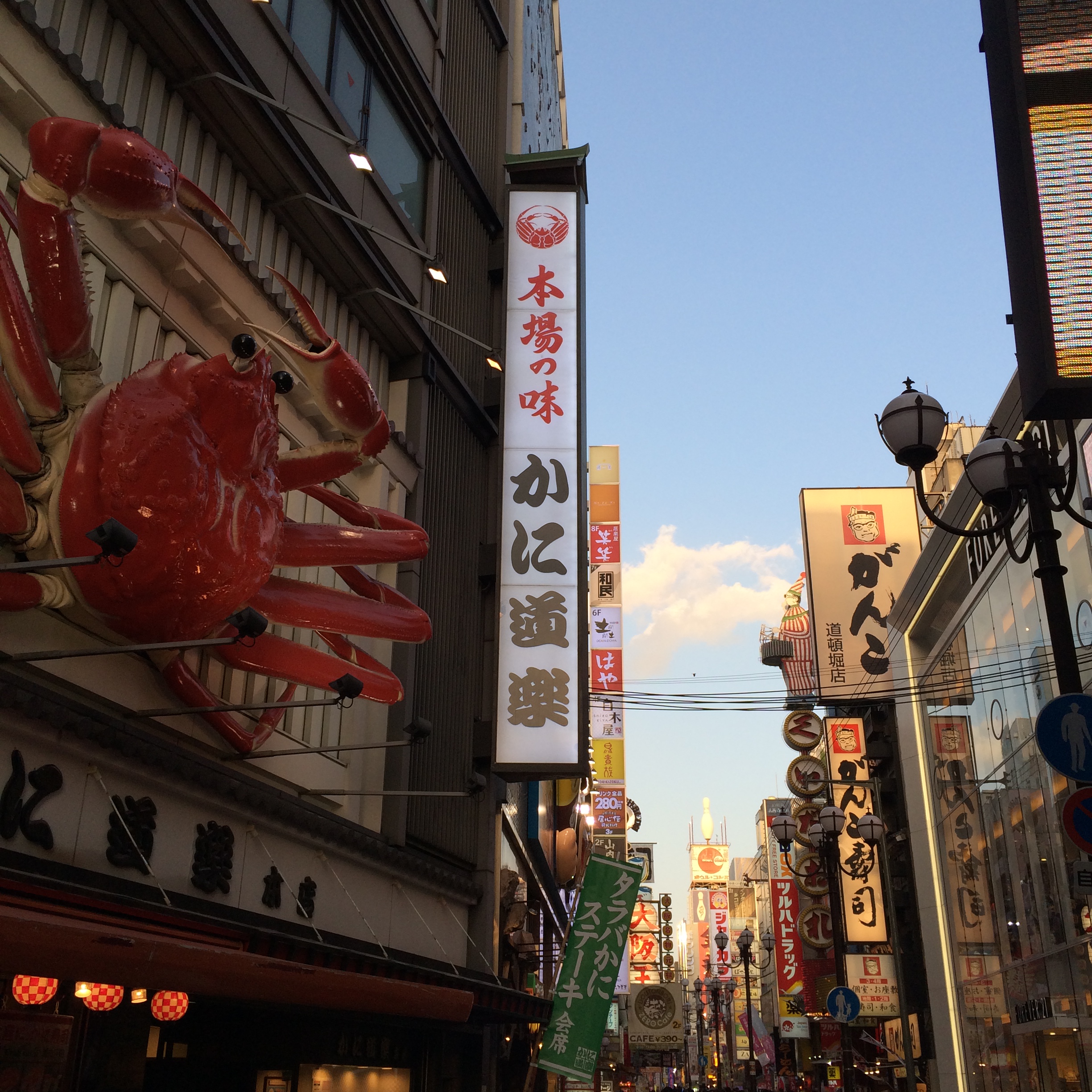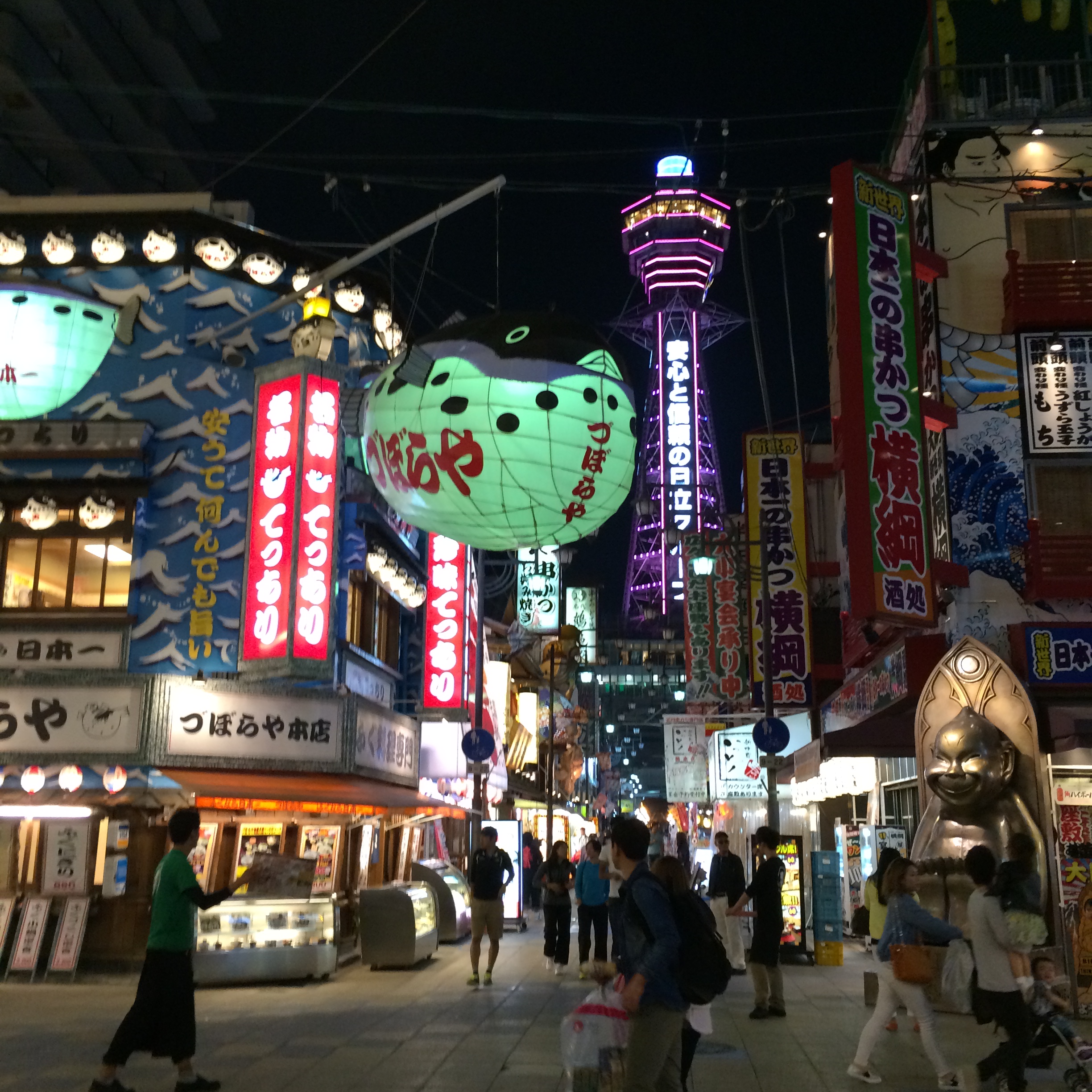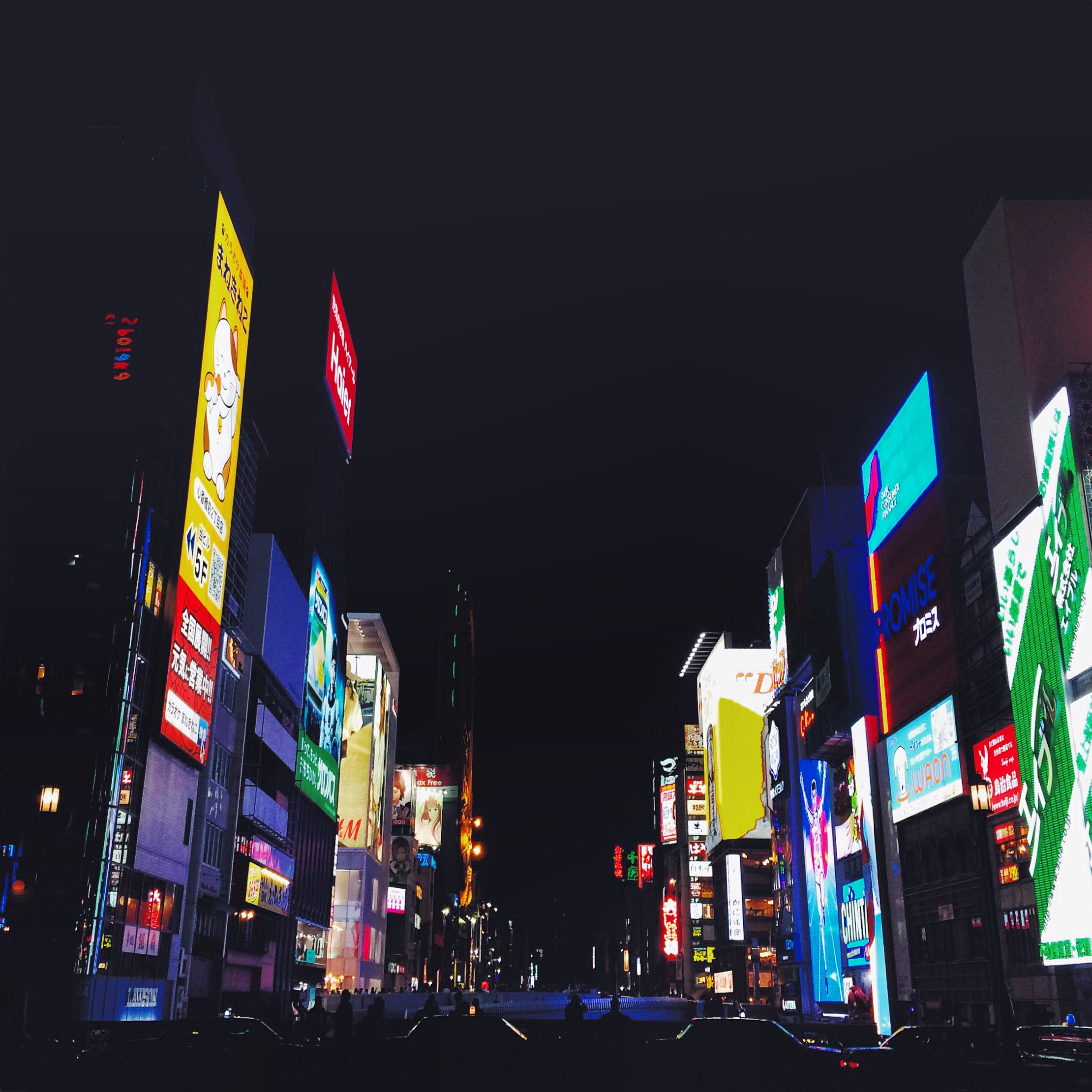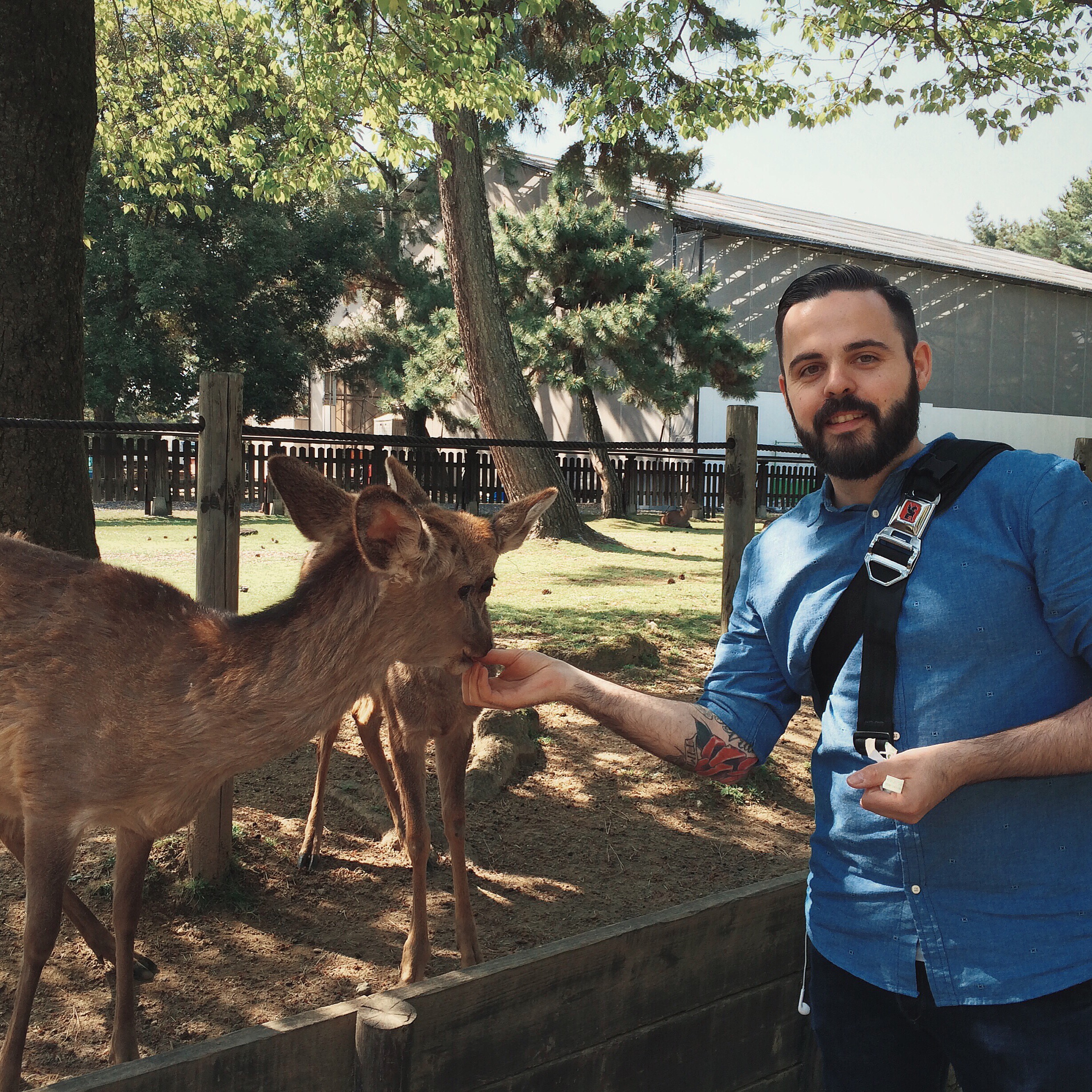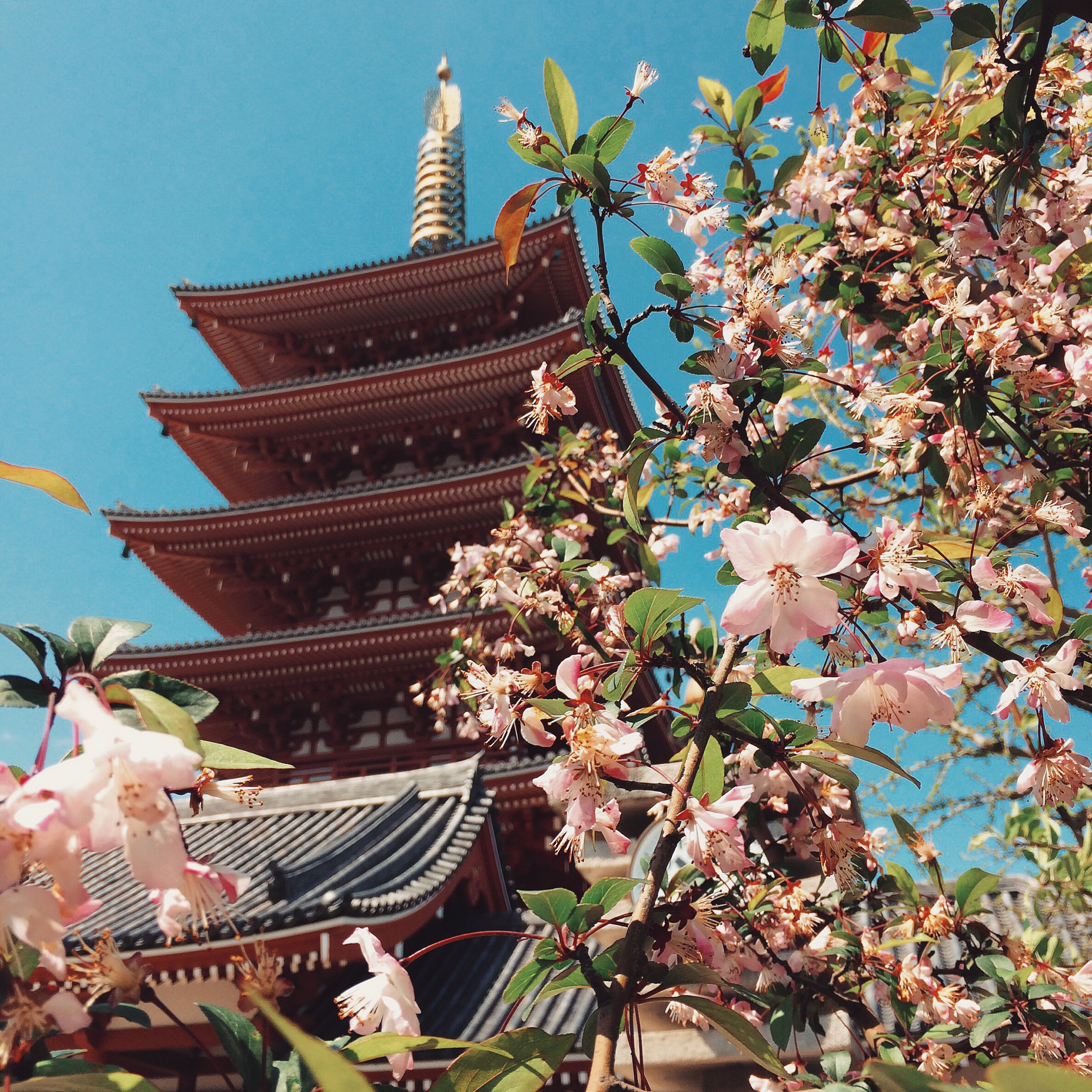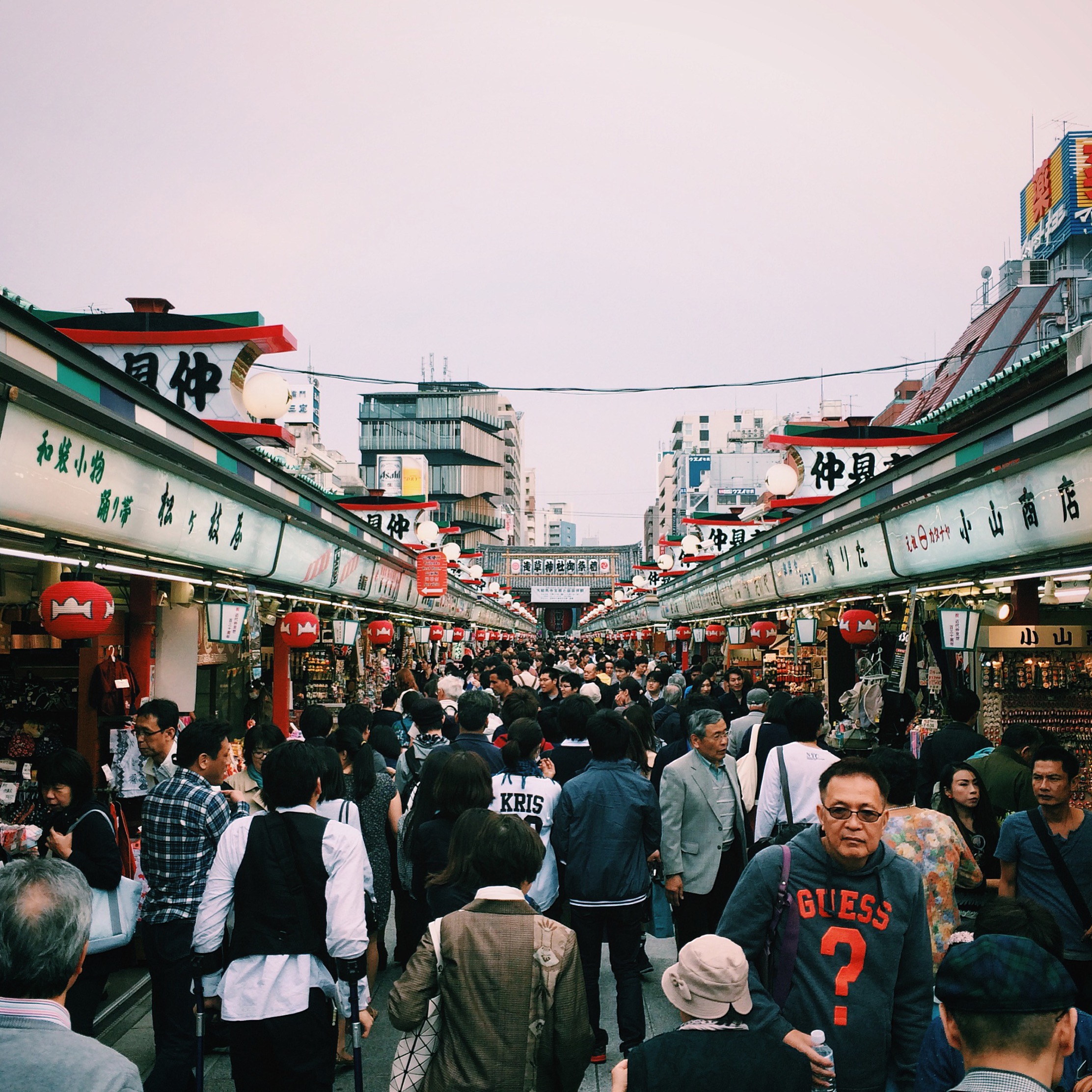Varanasi is supposed to be the oldest city of India. Not only the oldest, but also the holiest. Among the 5 cities I initially planned on visiting, Varanasi was the one I was really looking forward to discover.
On the airplane to India, I started reading a book about the Sadhus of India. "Sadhus" are holy men, considered as renunciants who have chosen to live their life apart from society to focus on their own spiritual practices. Some sadhus used to be wealthy and successful people, but they chose a path in their life where they would cut all familial, societal and earthly attachments. This way they could achieve their purest and highest spiritual level. Sadhus don't lead a normal life like others, they choose to live poorly and only find richness in spirit and humanity. I was told by a local in Varanasi, that they use the ashes of cremated bodies to cover their skin, because the ashes of the deceased is the last remaining of a human body on earth just before it reaches heaven & god.
I found the lifestyle of the Sadhus very fascinating. Sadly while discovering my first Sadhus in Varanasi, I was told that the holy men I'd meet along the ganges river, would be fake sadhus. Those were the beggars, who'd ask you for money if you'd take a photo of them. Which was actually true, some were even begging for a photo, because all they were looking for was getting a tip. Some of the boatmen considered those "fake sadhus" as lazy people, who were getting high all day, and they were making it through life just because of their fascinating look. I even noticed myself, that those sadhus were accepting money from the very poor people. The poor people were still convinced that the beggar sadhus, could bless them, for having a better life. That's how my interest in finishing the book about the Sadhus stopped! Nevertheless I was told, that there were real sadhus out there in Varanasi, but the real holy men, wouldn't hang out along the river. They would stay away from the crowds, and they would never dare to ask for a tip, if you would shoot any photos. The topic of the Sadhus still remains fascinating.
Varanasi, wasn't only about the Sadhus. On my first day, upon my arrival at the beautiful guesthouse "Ganpati", I was told that there were 3 main ghats "burning ghat", "assi ghat", and guess the next one, "main ghat". The stairs that lead down to a river are called "ghat", which are usually very big stairs, big enough to do any kind of activity like meditation, yoga, washing clothes, ...
The burning ghat is a public holy place where only Hindus cremate their departed in a sacred ritual. People are allowed to watch the whole ceremony, but taking photos isn't allowed, out of respect for their family. The locals still allow tourists to take photos from a boat, considering that you won't notice an morbid or personal details on a photo shot from a further distance. There are 2 cremation spots along the ganges river. At the "burning ghat" only hindus are allowed to get cremated. The cremations take place 24 hours a day, and 7 days a week. There's no time off. At the entrance to the ghat, people can weigh the wood, which is required to cremate the body. The cremation takes about 3 hours for one single body. The family gives the dead body a last massage at home, with natural oils, to make the deceased "feel good" for one last time, before they reach heaven. At the burning ghat, they wash the body right in the ganges river. Following the cleaning, they put the wrapped up body on the cremation spot. The relatives cover the body with the woods, and spread pieces of sandalwood over the body to accelerate the ignition of the deceased. The family members aren't supposed to cry in front of the body, the mourning takes place at home. After the cremation-process, the remaining ashes are shed into the river. The relatives aren't supposed to keep the ashes, otherwise the soul of the burnt body, would find its way back home. Pregnant women, children, holy men aren't allowed to get cremated, they get all wrapped up, and the whole body is thrown into the river. So there's a chance that you could witness a dead body floating on the water. Right next to the burning ghat there were lost buildings, where people used to spend their last days or weeks. Older people would come to Varanasi, just to die in Varanasi. They believe if they get cremated in the holy city, that they will make it to heaven, and won't get reborn in another life.
Burning Ghat
Another interesting fact was the "eternal flame of Shiva". Right next to the cremation ceremony you could notice a fire, which they used to ignite the bodies. That's the spot where one of Shiva's girlfriends set herself on fire. For more than a couple of hundreds years, people are responsible to keep that fire burning all day. All the dead bodies are lit up by the "eternal flame". It's not allowed to use any matches or lighters. The second cremation spot down the river, would allow non-hindu people to be cremated.
There were daily ceremonies, to praise the gods, at the main ghat (twice a day, at 06:30 in the morning and in the evening), and another early one at 06:00 in the morning at the assi ghat. The main ceremony at the main ghat, was interesting to watch for the first time. There were thousands of visitors every evening. I personally preferred the one in the early morning. Every morning I left my guest-house at 5:30, and walked towards the assi ghat. The walk took about 20-25 minutes. Sadly it wasn't a peaceful walk, because some boatmen were awake by then, and kept asking the early birds for boat rides.
The ceremony at 06:00 am at the assi ghat, started with a fire ceremony, were they burnt cow dung, to worship god. While they were doing their thing, you could observe the most beautiful sunrise arise. It was such a serene moment. And with a little luck, if you would find a spot close enough to the ceremony, the boatmen didn't dare to bother you. After the fire ceremony, followed a concert with indian meditation music, and a free yoga session. It was interesting to see the older generation sitting down on the floor and participating at the yoga class, which mainly consisted of pranayamas (breathing exercices). I wish I had participated as well, but all the instructions were in hindi, so i didn't feel comfortable sitting down among the locals, and too many tourists around me. It was also fascinating, to see how yoga is "normal thing" for the indians. People were dressed up in their daily clothes. Some used a towel, others just a plastic bag. There weren't any yoga mats, no fancy yoga clothes, ... it didn't look like trendy thing, as we know it from the western world. Some tourist girls tried to be even more indian than the locals, and they tried really hard to be the most convincing yogi among the locals. It looked so pathetic.
After the whole ceremony which lasted around 90 minutes, you could watch how the locals of Varanasi, made it the shore, to take a bath, wash their clothes. Another thing I hadn't seen before. Some of the locals were meditating towards the sunrise, others completed their yoga postures. Kids started running around. It felt very uncommon for me to see so much life in the streets at seven o'clock in the morning. Varanasi totally fulfilled my expectations, how I had imagined India.
However I gotta admit, after 3 nights in Varanasi, the endless "GOD" topics and stories, got a little to much. The locals would mention Shiva, Parvati, Ganesha, in every second sentence, it was all about the holy river of ganges, shiva power (weed), shiva-city (Varanasi), holy cows, pujas (prayer ritual)... The indians would even drink the water of the ganges river, the dirtiest of the dirtiest rivers.
The walks along the river and the different ghats never got boring. I totally appreciated the mix of street art, hand-painted letterings, and the very old architecture of the city. There wasn't much going on in the busy main streets of Varanasi. It just looked like any other indian city. The narrow alleys, that felt like a walk through a maze, were another charming part of the city. However the streets were most likely very dirty. Cow shit and urine all the way. Too many police officers on every corner, due to a recent threat by the pakistanis, who mentioned they would blow up the "golden temple" of Varanasi. That's why there were too many heavily armed police men, as well the military, securing the streets.
Even though the boatmen could get very annoying, the boat rides were the only quiet moment you would find along the river. I took about 3 boat rides during my stay in Varanasi. I got to know a lovely man, called "Diamond" (which is the translation of his hindi name). Even though, I was just another customer, Diamond seemed to be very legit, and I had the most interesting discussion with that man on his boat. The boatman explained me that there were too many boatmen on the river, more boats than tourists, which would make it pretty hard to earn any money. Diamond allowed me to switch places, and I had a chance to get a grip on the paddles. I gotta admit that it was a pretty hard job rowing for 30-60 minutes. Diamond was half my size, and he would keep on rowing for an hour. I could feel my shoulders getting tired after 5 minutes. Despite the amounts of physical power they had to put into the rowing, the boatmen only made 5 to 10 euros/dollars an hour.
Diamond proudly showed me his shiva tattoo, which he got in Goa (south of India). It was the last time Diamond had ever traveled. Because I was curious about his life, and his stories, I promised Diamond one last boat ride before I'd leave Varanasi. The next day, I took a last ride on his boat. As a gift, Diamond offered me one of his shiva-beeds necklaces. That was a lovely gift! Since the old man told me, that he couldn't afford any new clothes, I gave him two of my shirts I was carrying in my backpack. Diamond gladly accepted the shirts and thanked me with his shining eyes.
Varanasi was quite an experience. Now being back home for almost a week, and writing about the city on this post, I actually realize how unique the city was. While being in a city, we're so busy soaking up all the informations around us, the noises, the smells, the views, the people... and once we get back home, our mind gets the time to process all the informations we collected, especially when we start writing about it. That's what I like about my travel blog, it doesn't just keep me busy, sharing photos, videos, and stories with people all around the world, but it helps me processing the memories I collected on my trips, and bring them to "digital paper".
Update (02.04.2017).
Like I mentioned above, it really does take a while til you realize what you've been through on your journey across the world. I wish I could thank the "yogi" in my video on the top of this page, for being such an inspirational person. While I was observing the early morning yoga session, this gentleman just caught my eyes, and I kept observing him for a while. It just seemed very authentic to my eyes, and I was just blown away to see how much devotion this man put in his daily practice. I guess that's why I also chose to take a couple of shots & film-footage of him. High probably I just looked like any other tourist, taking photos of the locals. I really didn't want to offend anyone, and sometimes I just wish, I could show them what the end-product looks like. Of course it's not a professional documentary and it never will, but it's going to be a souvenir for the rest of my life. My memories in motion, which I will be able to share with my family & friends, and other travelers across the world.
Last friday during my first yoga class, following my trip to India, I was happy to witness that I hadn't lost any of my flexibility after a one-month-break. But the most beautiful part, was that everytime I closed my eyes during the asanas practice, Varanasi popped up in my mind. I had all these colors, the sunset, the children's choir chants, the morning yoga rituals, right in front of me. After the class I came to the conclusion that Varanasi had a bigger impact on myself, despite the numerous negative moments I went through on my India trip.
Sometimes we just aren't aware of what we experienced on our holidays, til the right moment kicks in, in the near future. I'm so glad that I had the chance to visit Varanasi, and that I was able to absorb and capture the sounds, the colors, the scents of the city.















